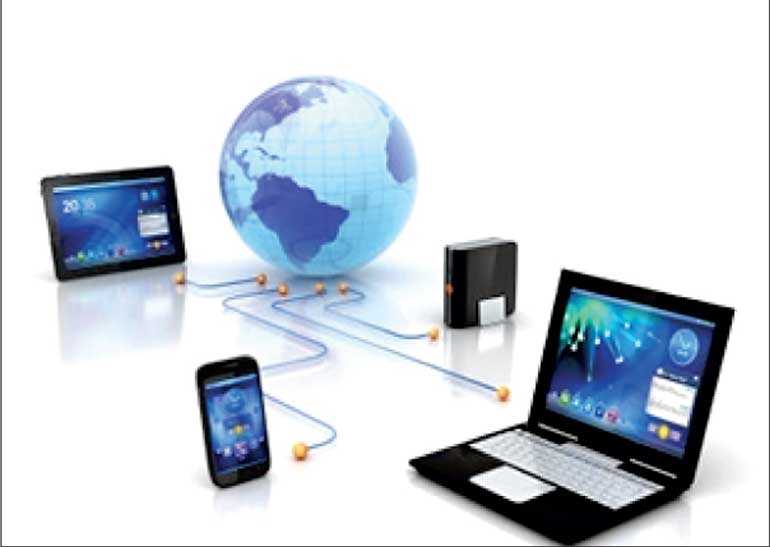Friday Apr 11, 2025
Friday Apr 11, 2025
Wednesday, 6 January 2021 00:00 - - {{hitsCtrl.values.hits}}

Sri Lanka has come far in the field of information communication technology but further efforts to develop and regulate the sector in a fair and expeditious manner should be taken to enable all stakeholders to benefit
 wait three-six hours to make a long-distance telephone calls to Colombo from his hometown Horowpothana even though he was a Member of Parliament and had ‘Official Priority’ calling facility.
wait three-six hours to make a long-distance telephone calls to Colombo from his hometown Horowpothana even though he was a Member of Parliament and had ‘Official Priority’ calling facility.
However, we tend to take for granted the communication facilities that we have presently. It is easy to forget the past and what led us to the present. The present pandemic too has accelerated the actions of more people using computers and telecommunication linked facilities for purposes of commercial and domestic communication and this has helped all greatly.
The purpose of this article is to outline the positive steps that all past governments took to develop Information and Communications Technology (ICT) in Sri Lanka. Before that, computers, telecommunications and media were almost ‘stand-alone’ activities. However, with the convergence of computer, telecommunication and media their inter-dependency led to this field being called Information and Communications Technology.
1977
With the formation of the Government of President J.R. Jayewardene and Prime Minister R. Premadasa, Sri Lanka took a giant stride in development moving to an ‘open economy’ and this was done with enabling legislation to facilitate market competition and de-regulating imports and exports. As a result, state corporations and the private sector adapted themselves to the free-market economy to play vital roles. This included the computer, telecommunication and media sectors as well.
1980s
During the 1989 Government of President R. Premadasa and Prime Minister D.B. Wijetunga, there were associations of software developers, hardware sales and service providers, all working with dedication to establish the industry. However, more encouragement was given with Industries, Science and Technology Minister Ranil Wickremesinghe chairing meetings of the organising committee to hold the first INFOTEL ‘92 ICT exhibition that gave national attention to the use of computers for development.
Towards the end of the period of the Government, the Department of Telecommunications was converted to a state entity as Sri Lanka Telecom with more autonomy and resources to meet the growing need for modern telecommunication services.
1994
The 1994 Government of President Chandrika Kumaratunga and Prime Minister Rathnasiri Wickremanayake took forward the predecessors’ efforts expeditiously. Telecommunications Minister Mangala Samaraweera led the privatisation of Sri Lanka Telecom. The privatisation took place with Nippon Telegraph and Telephone Corporation of Japan (NTT) purchasing 35% of shares and the employees of SLT also being given shares to ensure more employee participation. The NTT corporation thus brought in Japanese management and expertise. This helped SLT eliminate the delays encountered in providing telecom services to applicants.
The Government also took action to expand the post of the Director-General of Telecommunications to a fully-fledged commission named The Telecommunications Regulatory Commission of Sri Lanka by an act of Parliament.
This Regulatory Commission paved the way to clear many bottlenecks including the assignment of radio frequency spectrum in a transparent manner. It further ensured that radio frequency spectrum was deployed in an effective manner for telecommunication services. Contentious issues such as interconnection, caller party pays were addressed for subscribers to get maximum benefits from telecom services. It might be added that the service providers at that time were Sri Lanka Telecom, Suntel, Lanka Bell, Dialog, Celltell, Mobitel and Hutchison. The year 1993 saw Mobitel being established as mobile service provider as a collaboration between Sri Lanka Telecom and Telstra of Sweden. However, Mobitel was later purchased by Sri Lanka Telecom Ltd. during Chairman Thilanga Sumathipala’s time.
2001
The 2001 Government of President Chandrika Kumaratunga and Prime Minister Ranil Wickremesinghe further advanced activities related to the ICT sector. This included the ending of the monopoly of SLT for international communications. External gateway operator (EGO) licences were issued to the rest of the telecom operators and new entrants. This resulted in a reduction in the costs of overseas calls and further helped the country to connect with the rest of the world.
During this period, the Government and the TRC were supported by the World Bank to expedite reforms in ICT. Minster Milinda Moragoda of the Ministry of Economic Reform and Prof. Rohan Samarajiva, ICT and Public Policy Consultant co-ordinated the reforms through the Ministry of Mass Communication where Minister Imithiaz Bakeer-Marker led the Ministry and the TRC came under his purview.
A notable event that took place was the public auction of radio frequency spectrum to mobile cellular service operators to further modernise the mobile telephone services. Bids were called for the allocation of RF spectrum and millions of dollars were raised. Therefore, governments should note that radio frequency spectrum is public property, should be assigned at the highest possible prices so that the resources of governments will be augmented by billions of dollars.
The then Government also set up the Information and Communication Technology Agency of Sri Lanka by enacting enabling legislation in 2003. This new government agency succeeded the Computer Information Technology Council of Sri Lanka (CINTEC) which was the national policy maker and facilitator in ICT up to then.
As a result, the ICTA became the uppermost institution of government mandated to take all necessary steps to develop government policy and action plans in relation to ICT. Since success in ICT relied greatly on having good telecommunication systems and networks, the TRC and the ICTA worked in consultation with each other in most development matters. The writer remembers attending progress review meetings at the ICTA during that time.
This agency was tasked with the formulation and implementation of the Sri Lanka development project. The project was used to develop the economy, reduce poverty and improve the quality of life of the people with effective deployment of ICT resources all over the country.
2004
The 2004 Government of President Chandrika Kumaratunga and Prime Minister Mahinda Rajapaksa, took more positive and beneficial action to advance ICT. This included the induction of Bharati-Airtel Lanka as another mobile telecommunications service provider. This move ensured a wider choice for the public and ensured further competition in the sector.
With advancements in the internet, the Government recognised the need for a state agency to handle the matter of information security. This was to address cybercrimes and guide state agencies including the Police on how to handle cybercrimes. The ICTA created the Sri Lanka Computer Emergency Readiness Team (SLCERT) to ensure the protection of the information infrastructure. With the advancement of ICT, harassment of computer users, cyber-attacks on websites have increased exponentially. The police, other agencies of Government and the general public rely greatly on the SLCERT to solve their cyber-related issues. This entity is presently headed by Chairman Lal Dias, a Chartered Information Technology professional.
The Internet (World Wide Web)
In the 1960s the American defence authorities funded work for their internet to provide internal communication amongst multiple computers over a single network. Thereafter, research progressed until the world wide web was launched in 1983 and was made a commercial activity which allowed other countries to join the global internet thereafter.
In the 1990s, an initial demonstration for internet access in Sri Lanka was made under a project LEARN i.e., Lanka Experimental Academic and Research Network of the University of Moratuwa when computer engineers and academics demonstrated a successful remote log-in from the University of Moratuwa that was connected to a computer at the University of Colombo.
Thereafter, in 1995 LEARN facilitated the joining of academic and research communities to the global internet. Sri Lanka’s first e-mail service too was initiated by the University of Moratuwa. The rest is history.
The past and the pioneers
This article would not be complete unless the beginnings ICT and the pioneers associated with it are not mentioned.
The 1960s saw organisations and businesses like the State Engineering Corporation, Central Bank, Insurance Corporation, Petroleum Corporation, AMS Data Services and Walker Sons using large mainframe computers to process their internal tasks. It might be mentioned that each these computers were the size of a room, were comparatively slower and consumed much electricity.
The pioneers who made significant contributions to ICT development such as Prof. V.K. Samaranayake, Prof. Mohan Munasinghe, Prof. Gihan Dias, Dr. R.B. Ekanayake, Prof. Abhaya Induruwa, Nayani Fernando, being amongst the many who devoted themselves for the advancement of ICT in Sri Lanka.
The ‘LK Domain’ registry of Sri Lanka was set up in 1990. This registry has served Sri Lanka as its professional domain registration service and enhanced the development of internet infrastructure for internet. The registry provides the national domain name for Sri Lankan organisations and individuals to create their unique brand identity on the internet with domains such as…..lk, .com.lk, .org.lk and .edu.lk.
The JVP and LTTE insurrections
Sri Lanka had two serious insurgencies from 1983 to 2009 where telecom exchanges were destroyed and broadcast relay stations were destroyed. However, state and private sector engineers and technicians worked with commitment under trying conditions during these times to restore interrupted services and we appreciate their bravery and commitment.
In conclusion, Sri Lanka has come far in the field of information communication technology but further efforts to develop and regulate the sector in a fair and expeditious manner should be taken to enable all stakeholders to benefit.
(The writer is former Minister of Science and Technology and former Director-General, Telecommunications Regulatory Commission of Sri Lanka.)
Discover Kapruka, the leading online shopping platform in Sri Lanka, where you can conveniently send Gifts and Flowers to your loved ones for any event including Valentine ’s Day. Explore a wide range of popular Shopping Categories on Kapruka, including Toys, Groceries, Electronics, Birthday Cakes, Fruits, Chocolates, Flower Bouquets, Clothing, Watches, Lingerie, Gift Sets and Jewellery. Also if you’re interested in selling with Kapruka, Partner Central by Kapruka is the best solution to start with. Moreover, through Kapruka Global Shop, you can also enjoy the convenience of purchasing products from renowned platforms like Amazon and eBay and have them delivered to Sri Lanka.
Discover Kapruka, the leading online shopping platform in Sri Lanka, where you can conveniently send Gifts and Flowers to your loved ones for any event including Valentine ’s Day. Explore a wide range of popular Shopping Categories on Kapruka, including Toys, Groceries, Electronics, Birthday Cakes, Fruits, Chocolates, Flower Bouquets, Clothing, Watches, Lingerie, Gift Sets and Jewellery. Also if you’re interested in selling with Kapruka, Partner Central by Kapruka is the best solution to start with. Moreover, through Kapruka Global Shop, you can also enjoy the convenience of purchasing products from renowned platforms like Amazon and eBay and have them delivered to Sri Lanka.